Dielectrophoresis6
The motion of neutral particles due to electric field gradients.
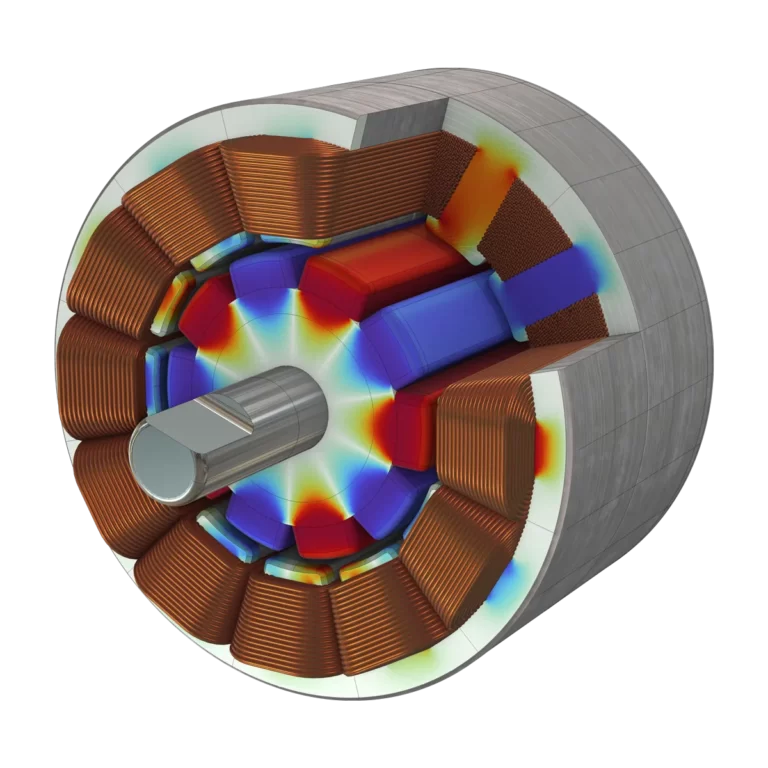
Simulate Low-Frequency Electromagnetics and Electromechanical Components
Analyzing electromagnetic systems and processes that encompass the static and low-frequency ranges requires a powerful and flexible simulation tool. The AC/DC Module add-on to the COMSOL Multiphysics® platform provides you with a wide range of modeling features and numerical methods for investigating electromagnetic fields and EMI/EMC by solving Maxwell's equations.
The multiphysics capabilities of the COMSOL® software make it possible to investigate the impact of other physical effects — such as heat transfer, structural mechanics, and acoustics — on an electromagnetics model.
Simulate Low-Frequency Electromagnetics and Electromechanical Components
Analyzing electromagnetic systems and processes that encompass the static and low-frequency ranges requires a powerful and flexible simulation tool. The AC/DC Module add-on to the COMSOL Multiphysics® platform provides you with a wide range of modeling features and numerical methods for investigating electromagnetic fields and EMI/EMC by solving Maxwell's equations.
The multiphysics capabilities of the COMSOL® software make it possible to investigate the impact of other physical effects — such as heat transfer, structural mechanics, and acoustics — on an electromagnetics model.

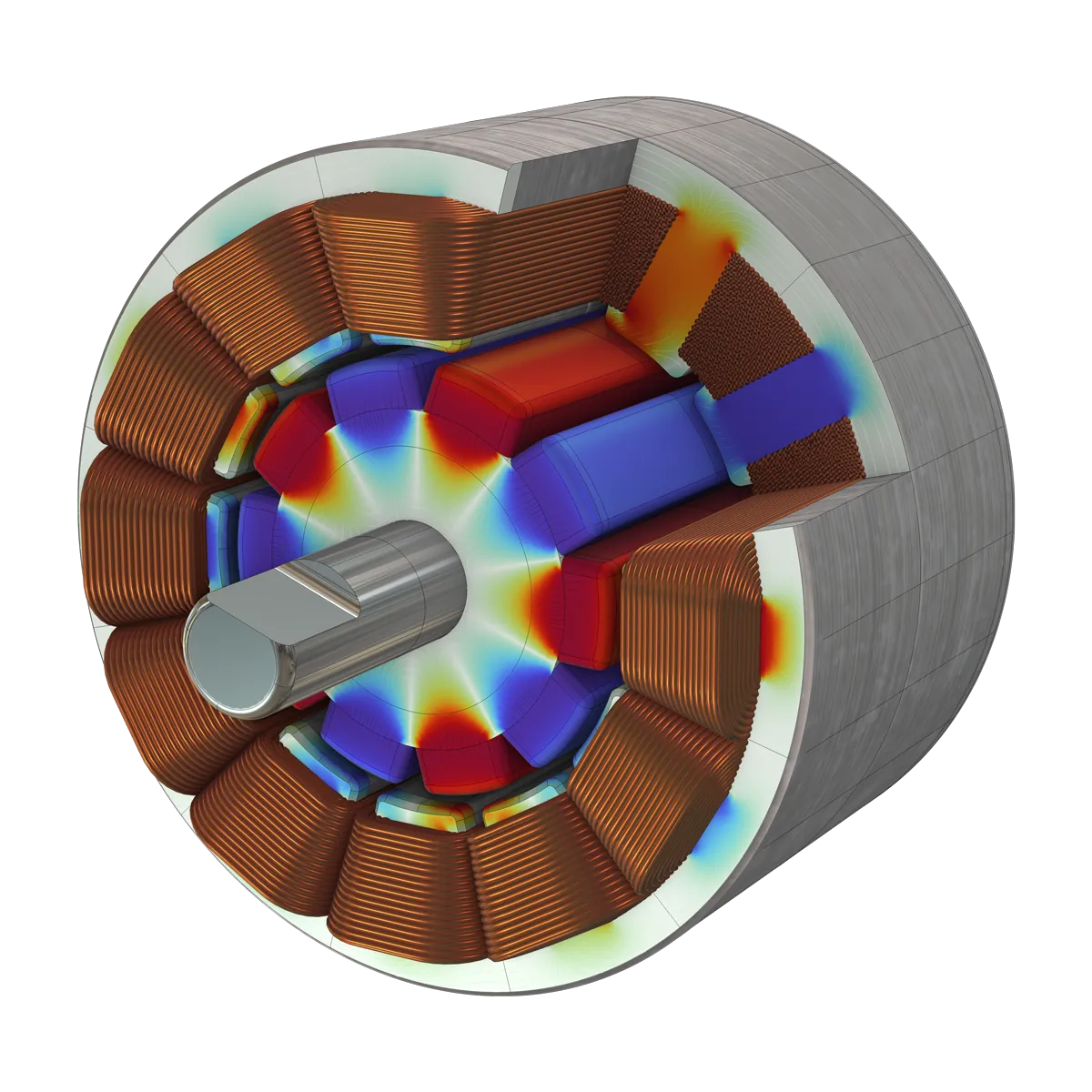
Simulate Low-Frequency Electromagnetics and Electromechanical Components
Analyzing electromagnetic systems and processes that encompass the static and low-frequency ranges requires a powerful and flexible simulation tool. The AC/DC Module add-on to the COMSOL Multiphysics® platform provides you with a wide range of modeling features and numerical methods for investigating electromagnetic fields and EMI/EMC by solving Maxwell's equations.
The multiphysics capabilities of the COMSOL® software make it possible to investigate the impact of other physical effects — such as heat transfer, structural mechanics, and acoustics — on an electromagnetics model.
Simulate Low-Frequency Electromagnetics and Electromechanical Components
Analyzing electromagnetic systems and processes that encompass the static and low-frequency ranges requires a powerful and flexible simulation tool. The AC/DC Module add-on to the COMSOL Multiphysics® platform provides you with a wide range of modeling features and numerical methods for investigating electromagnetic fields and EMI/EMC by solving Maxwell's equations.
The multiphysics capabilities of the COMSOL® software make it possible to investigate the impact of other physical effects — such as heat transfer, structural mechanics, and acoustics — on an electromagnetics model.
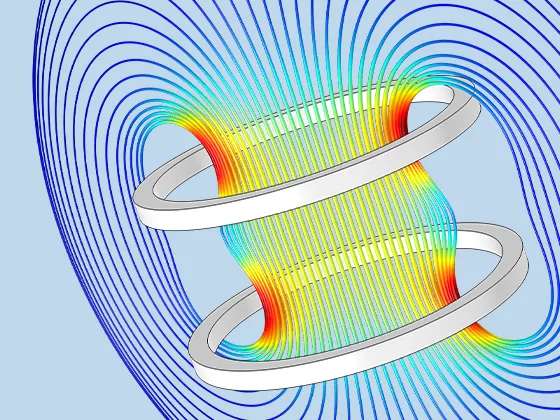

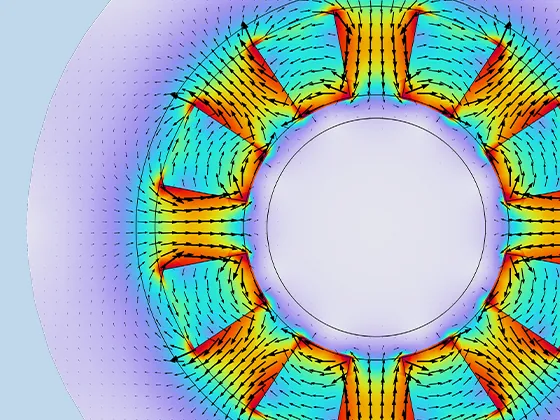





Simulate Low-Frequency Electromagnetics and Electromechanical Components
Analyzing electromagnetic systems and processes that encompass the static and low-frequency ranges requires a powerful and flexible simulation tool. The AC/DC Module add-on to the COMSOL Multiphysics® platform provides you with a wide range of modeling features and numerical methods for investigating electromagnetic fields and EMI/EMC by solving Maxwell's equations.
The multiphysics capabilities of the COMSOL® software make it possible to investigate the impact of other physical effects — such as heat transfer, structural mechanics, and acoustics — on an electromagnetics model.
Simulate Low-Frequency Electromagnetics and Electromechanical Components
Analyzing electromagnetic systems and processes that encompass the static and low-frequency ranges requires a powerful and flexible simulation tool. The AC/DC Module add-on to the COMSOL Multiphysics® platform provides you with a wide range of modeling features and numerical methods for investigating electromagnetic fields and EMI/EMC by solving Maxwell's equations.
The multiphysics capabilities of the COMSOL® software make it possible to investigate the impact of other physical effects — such as heat transfer, structural mechanics, and acoustics — on an electromagnetics model.

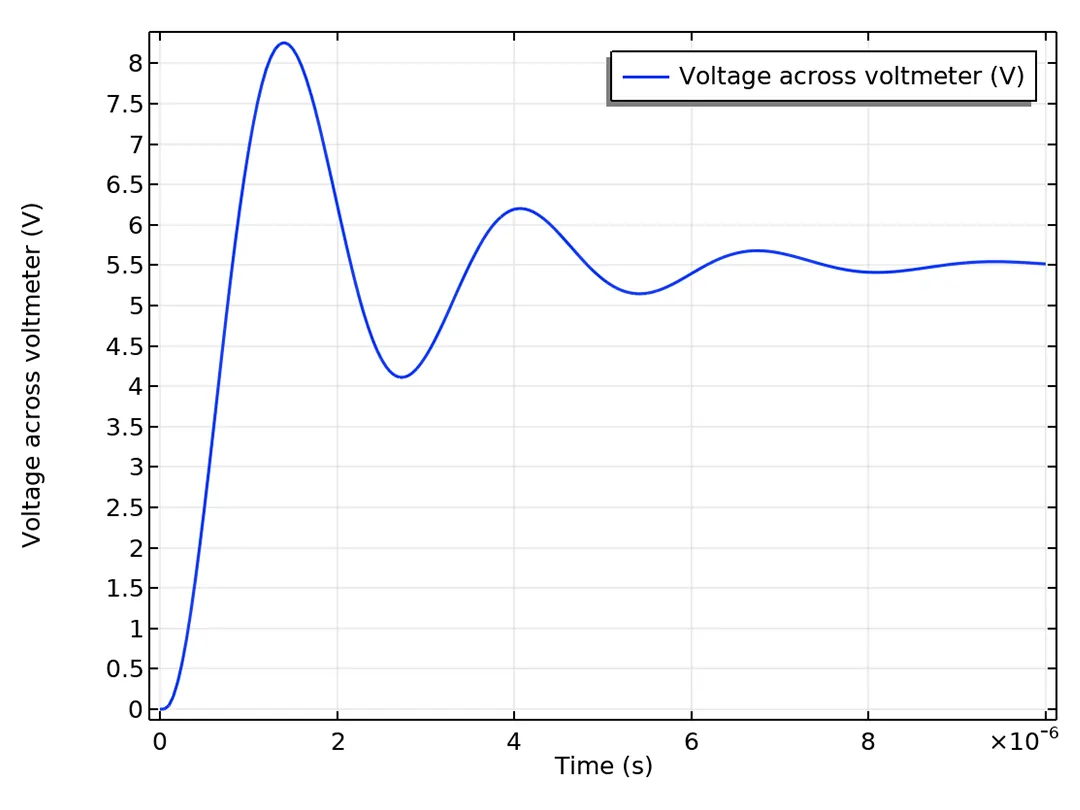
Simulate Low-Frequency Electromagnetics and Electromechanical Components
Analyzing electromagnetic systems and processes that encompass the static and low-frequency ranges requires a powerful and flexible simulation tool. The AC/DC Module add-on to the COMSOL Multiphysics® platform provides you with a wide range of modeling features and numerical methods for investigating electromagnetic fields and EMI/EMC by solving Maxwell's equations.
The multiphysics capabilities of the COMSOL® software make it possible to investigate the impact of other physical effects — such as heat transfer, structural mechanics, and acoustics — on an electromagnetics model.
The AC/DC Module contains specialized features and functionality for the various capabilities presented on this page.
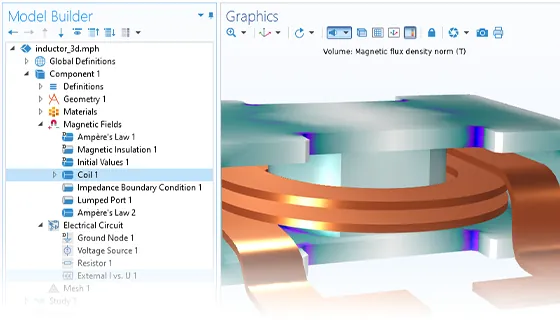
The AC/DC Module provides built-in user interfaces for each of the electromagnetics areas listed above, as well as variations for specific modeling purposes. These interfaces each define sets of domain equations, boundary conditions, initial conditions, predefined meshes, predefined studies with solver settings for steady and transient analyses, as well as predefined plots and derived values.
There are also features that connect the different interfaces, to easily model them together, which can be convenient for inductors, coils, and motors.

The AC/DC Module provides built-in user interfaces for each of the electromagnetics areas listed above, as well as variations for specific modeling purposes. These interfaces each define sets of domain equations, boundary conditions, initial conditions, predefined meshes, predefined studies with solver settings for steady and transient analyses, as well as predefined plots and derived values.
There are also features that connect the different interfaces, to easily model them together, which can be convenient for inductors, coils, and motors.

The AC/DC Module provides built-in user interfaces for each of the electromagnetics areas listed above, as well as variations for specific modeling purposes. These interfaces each define sets of domain equations, boundary conditions, initial conditions, predefined meshes, predefined studies with solver settings for steady and transient analyses, as well as predefined plots and derived values.
There are also features that connect the different interfaces, to easily model them together, which can be convenient for inductors, coils, and motors.

The AC/DC Module provides built-in user interfaces for each of the electromagnetics areas listed above, as well as variations for specific modeling purposes. These interfaces each define sets of domain equations, boundary conditions, initial conditions, predefined meshes, predefined studies with solver settings for steady and transient analyses, as well as predefined plots and derived values.
There are also features that connect the different interfaces, to easily model them together, which can be convenient for inductors, coils, and motors.
affect and are affected by multiple physics phenomena. In COMSOL Multiphysics®, this is no different than modeling a single-physics problem.
samsung amp y gy gyug uylll g lg gyfgy fsamsung amp y gy gyug uylll g lg gyfgy f
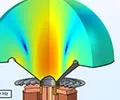
samsung amp y gy gyug uylll g lg gyfgy fsamsung amp y gy gyug uylll g lg gyfgy f

samsung amp y gy gyug uylll g lg gyfgy fsamsung amp y gy gyug uylll g lg gyfgy f

samsung amp y gy gyug uylll g lg gyfgy fsamsung amp y gy gyug uylll g lg gyfgy f

samsung amp y gy gyug uylll g lg gyfgy fsamsung amp y gy gyug uylll g lg gyfgy f

samsung amp y gy gyug uylll g lg gyfgy fsamsung amp y gy gyug uylll g lg gyfgy f

The motion of neutral particles due to electric field gradients.

Simulate Low-Frequency Electromagnetics and Electromechanical Components
Analyzing electromagnetic systems and processes that encompass the static and low-frequency ranges requires a powerful and flexible simulation tool. The AC/DC Module add-on to the COMSOL Multiphysics® platform provides you with a wide range of modeling features and numerical methods for investigating electromagnetic fields and EMI/EMC by solving Maxwell's equations.
The multiphysics capabilities of the COMSOL® software make it possible to investigate the impact of other physical effects — such as heat transfer, structural mechanics, and acoustics — on an electromagnetics model.
Simulate Low-Frequency Electromagnetics and Electromechanical Components
Analyzing electromagnetic systems and processes that encompass the static and low-frequency ranges requires a powerful and flexible simulation tool. The AC/DC Module add-on to the COMSOL Multiphysics® platform provides you with a wide range of modeling features and numerical methods for investigating electromagnetic fields and EMI/EMC by solving Maxwell's equations.
The multiphysics capabilities of the COMSOL® software make it possible to investigate the impact of other physical effects — such as heat transfer, structural mechanics, and acoustics — on an electromagnetics model.


Simulate Low-Frequency Electromagnetics and Electromechanical Components
Analyzing electromagnetic systems and processes that encompass the static and low-frequency ranges requires a powerful and flexible simulation tool. The AC/DC Module add-on to the COMSOL Multiphysics® platform provides you with a wide range of modeling features and numerical methods for investigating electromagnetic fields and EMI/EMC by solving Maxwell's equations.
The multiphysics capabilities of the COMSOL® software make it possible to investigate the impact of other physical effects — such as heat transfer, structural mechanics, and acoustics — on an electromagnetics model.
Simulate Low-Frequency Electromagnetics and Electromechanical Components
Analyzing electromagnetic systems and processes that encompass the static and low-frequency ranges requires a powerful and flexible simulation tool. The AC/DC Module add-on to the COMSOL Multiphysics® platform provides you with a wide range of modeling features and numerical methods for investigating electromagnetic fields and EMI/EMC by solving Maxwell's equations.
The multiphysics capabilities of the COMSOL® software make it possible to investigate the impact of other physical effects — such as heat transfer, structural mechanics, and acoustics — on an electromagnetics model.








Simulate Low-Frequency Electromagnetics and Electromechanical Components
Analyzing electromagnetic systems and processes that encompass the static and low-frequency ranges requires a powerful and flexible simulation tool. The AC/DC Module add-on to the COMSOL Multiphysics® platform provides you with a wide range of modeling features and numerical methods for investigating electromagnetic fields and EMI/EMC by solving Maxwell's equations.
The multiphysics capabilities of the COMSOL® software make it possible to investigate the impact of other physical effects — such as heat transfer, structural mechanics, and acoustics — on an electromagnetics model.
Simulate Low-Frequency Electromagnetics and Electromechanical Components
Analyzing electromagnetic systems and processes that encompass the static and low-frequency ranges requires a powerful and flexible simulation tool. The AC/DC Module add-on to the COMSOL Multiphysics® platform provides you with a wide range of modeling features and numerical methods for investigating electromagnetic fields and EMI/EMC by solving Maxwell's equations.
The multiphysics capabilities of the COMSOL® software make it possible to investigate the impact of other physical effects — such as heat transfer, structural mechanics, and acoustics — on an electromagnetics model.


Simulate Low-Frequency Electromagnetics and Electromechanical Components
Analyzing electromagnetic systems and processes that encompass the static and low-frequency ranges requires a powerful and flexible simulation tool. The AC/DC Module add-on to the COMSOL Multiphysics® platform provides you with a wide range of modeling features and numerical methods for investigating electromagnetic fields and EMI/EMC by solving Maxwell's equations.
The multiphysics capabilities of the COMSOL® software make it possible to investigate the impact of other physical effects — such as heat transfer, structural mechanics, and acoustics — on an electromagnetics model.
The AC/DC Module contains specialized features and functionality for the various capabilities presented on this page.

The AC/DC Module provides built-in user interfaces for each of the electromagnetics areas listed above, as well as variations for specific modeling purposes. These interfaces each define sets of domain equations, boundary conditions, initial conditions, predefined meshes, predefined studies with solver settings for steady and transient analyses, as well as predefined plots and derived values.
There are also features that connect the different interfaces, to easily model them together, which can be convenient for inductors, coils, and motors.

The AC/DC Module provides built-in user interfaces for each of the electromagnetics areas listed above, as well as variations for specific modeling purposes. These interfaces each define sets of domain equations, boundary conditions, initial conditions, predefined meshes, predefined studies with solver settings for steady and transient analyses, as well as predefined plots and derived values.
There are also features that connect the different interfaces, to easily model them together, which can be convenient for inductors, coils, and motors.

The AC/DC Module provides built-in user interfaces for each of the electromagnetics areas listed above, as well as variations for specific modeling purposes. These interfaces each define sets of domain equations, boundary conditions, initial conditions, predefined meshes, predefined studies with solver settings for steady and transient analyses, as well as predefined plots and derived values.
There are also features that connect the different interfaces, to easily model them together, which can be convenient for inductors, coils, and motors.

The AC/DC Module provides built-in user interfaces for each of the electromagnetics areas listed above, as well as variations for specific modeling purposes. These interfaces each define sets of domain equations, boundary conditions, initial conditions, predefined meshes, predefined studies with solver settings for steady and transient analyses, as well as predefined plots and derived values.
There are also features that connect the different interfaces, to easily model them together, which can be convenient for inductors, coils, and motors.
affect and are affected by multiple physics phenomena. In COMSOL Multiphysics®, this is no different than modeling a single-physics problem.
samsung amp y gy gyug uylll g lg gyfgy fsamsung amp y gy gyug uylll g lg gyfgy f

samsung amp y gy gyug uylll g lg gyfgy fsamsung amp y gy gyug uylll g lg gyfgy f

samsung amp y gy gyug uylll g lg gyfgy fsamsung amp y gy gyug uylll g lg gyfgy f

samsung amp y gy gyug uylll g lg gyfgy fsamsung amp y gy gyug uylll g lg gyfgy f

samsung amp y gy gyug uylll g lg gyfgy fsamsung amp y gy gyug uylll g lg gyfgy f

samsung amp y gy gyug uylll g lg gyfgy fsamsung amp y gy gyug uylll g lg gyfgy f

The motion of neutral particles due to electric field gradients.